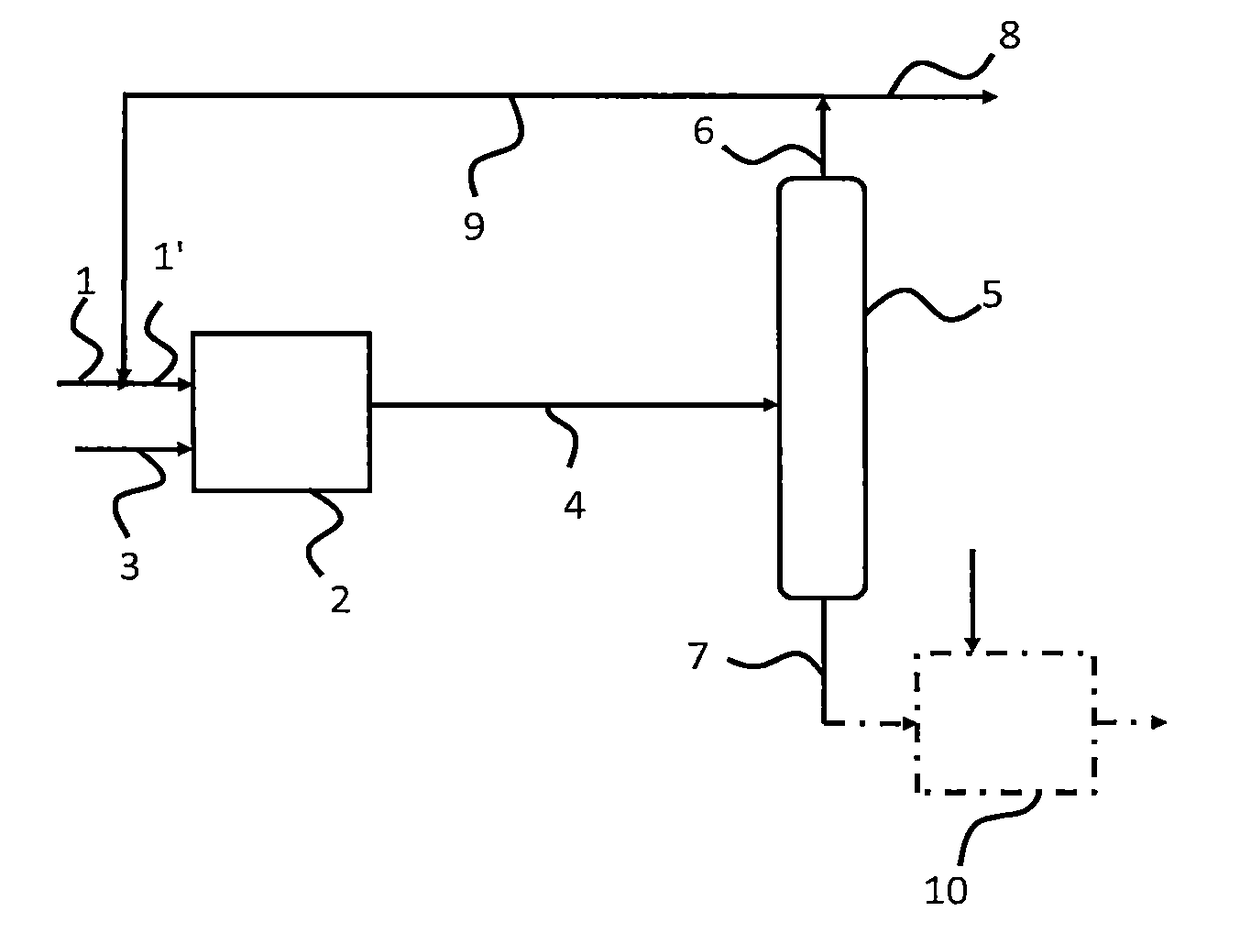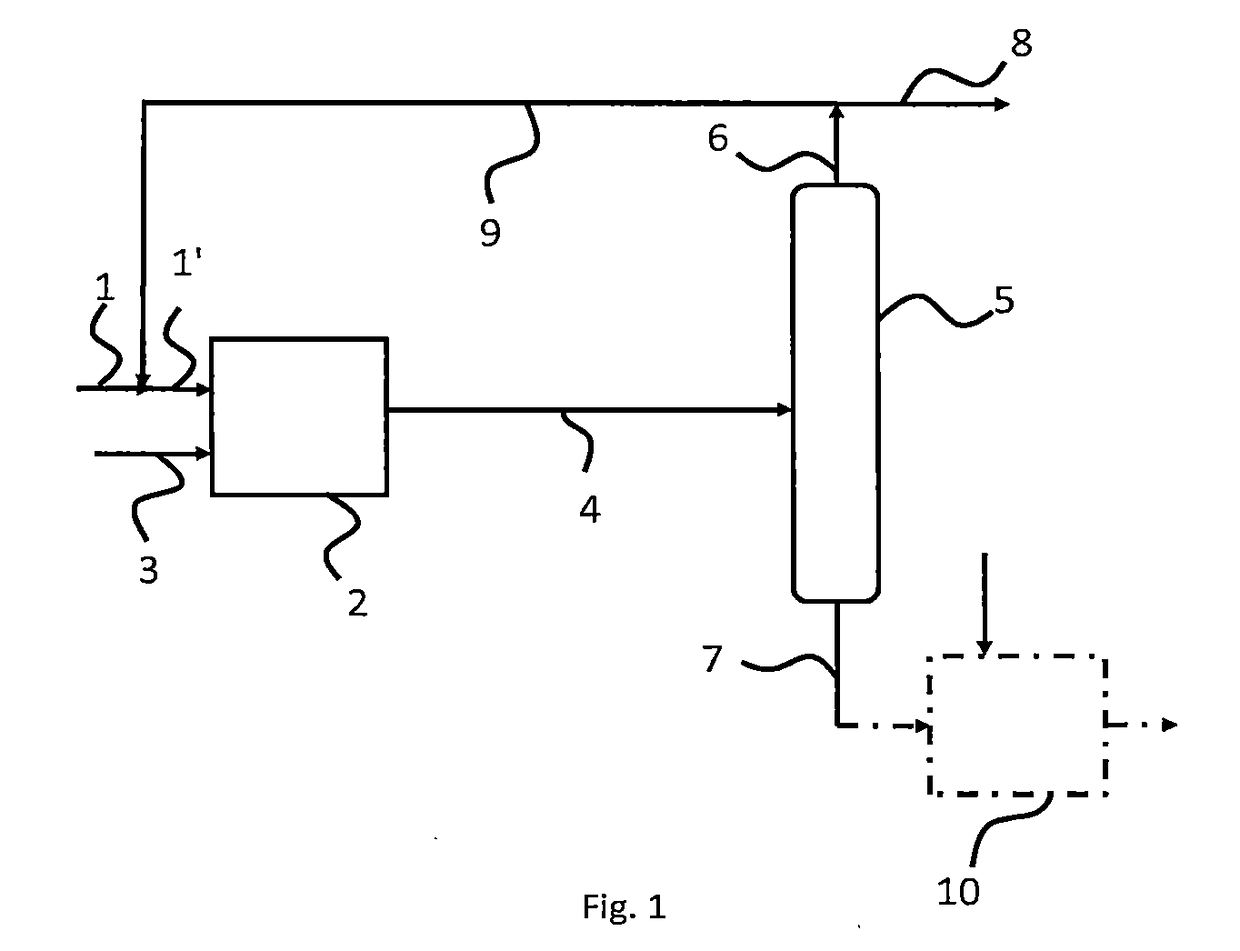Method for sweetening an olefinic petrol of sulphide-type compounds
- Summary
- Abstract
- Description
- Claims
- Application Information
AI Technical Summary
Benefits of technology
Problems solved by technology
Method used
Image
Examples
example 2 (
According to the Invention)
[0086]The gasoline of Example 1 is treated in the process according to the invention with a recycle ratio of 0.5.
[0087]Taking into account the recycling, the feedstock treated in the presence of catalyst A in the selective hydrogenation reactor has a content of dimethyl-sulphide and methyl-ethyl-sulphide of respectively 2.1 and 4.4 ppm by weight.
[0088]Catalyst A is a catalyst of NiMo type on gamma alumina. The contents of metals are respectively 7% by weight NiO and 11% by weight MoO3 with respect to the total weight of the catalyst, i.e. an Ni / Mo molar ratio of 1.2. The specific surface area of the catalyst is 230 m2 / g. Prior to its use, the catalyst A is sulphurized at atmospheric pressure on a sulphurization bench under an H2S / H2 mixture constituted by 15% by volume of H2S to 1 L / g·h of catalyst and at 400° C. for two hours. This protocol makes it possible to obtain a degree of sulphurization greater than 80%.
TABLE 3Dimethyl-sulphideMethyl-ethyl-sulphid...
example 3 (
According to the Invention)
[0091]The gasoline of Example 1 is treated in the process according to the invention with a recycle ratio of 0.33.
[0092]Taking into account the recycling, the feedstock treated in the presence of catalyst A in the selective hydrogenation reactor has a content of dimethyl-sulphide and methyl-ethyl-sulphide of respectively 2.0 and 4.5 ppm by weight.
[0093]Catalyst A is a catalyst of NiMo type on gamma alumina. The contents of metals are respectively 7% by weight NiO and 11% by weight MoO3 with respect to the total weight of the catalyst, i.e. an Ni / Mo molar ratio of 1.2. The specific surface area of the catalyst is 230 m2 / g. Prior to its use, the catalyst A is sulphurized at atmospheric pressure on a sulphurization bench under an H2S / H2 mixture constituted by 15% by volume of H2S to 1 L / g·h of catalyst and at 400° C. for two hours. This protocol makes it possible to obtain a degree of sulphurization greater than 80%.
TABLE 4Dimethyl-sulphideMethyl-ethyl-sulphi...
PUM
| Property | Measurement | Unit |
|---|---|---|
| Fraction | aaaaa | aaaaa |
| Percent by mass | aaaaa | aaaaa |
| Percent by mass | aaaaa | aaaaa |
Abstract
Description
Claims
Application Information
 Login to View More
Login to View More - R&D
- Intellectual Property
- Life Sciences
- Materials
- Tech Scout
- Unparalleled Data Quality
- Higher Quality Content
- 60% Fewer Hallucinations
Browse by: Latest US Patents, China's latest patents, Technical Efficacy Thesaurus, Application Domain, Technology Topic, Popular Technical Reports.
© 2025 PatSnap. All rights reserved.Legal|Privacy policy|Modern Slavery Act Transparency Statement|Sitemap|About US| Contact US: help@patsnap.com


